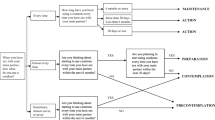Abstract
This pilot study evaluated whether brief safer sex interventions for women partners of male injection drug users significantly influenced perceptions of partner risk, human immunodeficiency virus (HIV) knowledge, correct condom usage, and self-reported consistent safer sex (abstinence or 100% of vaginal-penile intercourse acts protected by male or female condoms). The study also examined the impact of pretest assessment on those variables since pretest assessment may challenge participants' current knowledge, safer sex practices, and partner communication techniques. The study randomly assigned participants to pretest or no pretest assessment. Each group was also assigned randomly to a presentation modality: (1) safer sex pamphlet review only, (2) pamphlet review with demonstration of several safer sex alternatives, or (3) pamphlet review with skills practice to mastery with one safer sex alternative of the woman's choice. For the last two conditions, a 35-minute interactive session covered prevention efficacy of safer sex methods for HIV, sexually transmitted infections, pregnancy, correct use, eroticization, local cost and availability, and partner objections. At 7 weeks postintervention, a higher proportion of women who took pretest assessment reported consistent safer sex (66.7%) compared to those without pretests (55.6%). Assignment to the interactive interventions (skills or demonstration) had little additional impact over pretest assessment for these women. Among women who did not take pretests, the interactive interventions had strong effects; 76.9% reported consistent safer sex versus 33.3% in the pamphlet review group. There were additional specific effects for pretest assessment on HIV knowledge and partner risk perception and for interactive intervention on correct condom usage. Brief interventions appear to have some positive short-term effects. Pretest assessment may be an important component of brief interventions.
Similar content being viewed by others
References
Centers for Disease Control and Prevention.HIV/AIDS Surveillance Report. Atlanta, GA: Centers for Disease Control and Prevention; 1998.
New York City Department of Health Office of AIDS Surveillance.Estimates of Persons Living with AIDS in New York City. New York: New York City Department of Health Office of AIDS Surveillance; 1999.
Friedman SR, Des Jarlais DC, Ward TP, Jose B, Neaigus A, Goldstein MF. Drug injectors and heterosexual AIDS. In Sherr L, ed.Heterosexual AIDS. Chur, Switzerland: Harwood Academic, 1993:41–65.
Morrill AC, Ickovics JR, Golubchikov VV, Beren SE, Rodin J. Safer sex: social and psychological predictors of behavioral maintenance and change among heterosexual women.J Consult Clin Psychol. 1996;64:819–828.
Sikkema KJ, Koob JJ, Cargill VC, et al. Levels and predictors of HIV risk behavior among women in low-income public housing developments.Public Health Rep. 1995; 110:707–713.
Tross S, Krauss B, Andia J, Sanchez M, Long S. Condom use intention and behavior among female sexual partners of injection drug users in New York City: findings from a community-level intervention. Paper presented at: National Institute on Drug Abuse Second Science Symposium on Drugs, Sex and AIDS: Prevention Research, 1995–2000; August 1994; Flagstaff, AZ.
National Institute of Mental Health (NIMH) Multisite HIV Prevention Trial Group. The NIMH multisite HIV prevention trial: reducing HIV sexual risk behavior.Science. 1998;80:1889–1894.
Deren S, Davis WR, Beardsley M, Tortu S, Clatts M. Outcomes of a risk-reduction intervention with high-risk populations: the Harlem AIDS Project.AIDS Educ Prev. 1995;7:379–390.
Kalichman SC, Kelly JA, Stevenson LY. Priming effects of HIV risk assessments on related perceptions and behavior: an experimental field study.AIDS Behav. 1997;1:3–8.
DiClemente RJ, Wingood GM. A randomized controlled trial of and HIV sexual risk-reduction intervention for young African-American women.JAMA. 1995;274:1271–1275.
Bandura A.Social Foundations of Throught and Action: a Social Cognitive Theory. Englewood Cliffs, NJ: Prentice Hall; 1986.
Kanfer FH, Gaelick L. Self-management methods. In Kanfer F, Goldstein H, eds.Helping People Change: a Textbook of Methods. New York: Pergamon; 1986:283–345.
Campbell DT, Stanley J.Experimental and Quasi-Experimental Designs for Research. Boston: Houghton Mifflin; 1963.
Hintze JL.PASS User's Guide: Power Analysis and Sample Size for Windows. Kaysville, UT: NCSS; 1996.
Cohen J. A power primer.Psychol Bull. 1992;112:155–159.
Centers for Disease Control and Prevention AIDS Community Demonstration Projects Research Group. Community-level HIV intervention in 5 cities: final outcome data from the CDC AIDS Community Demonstration Projects.Am J Public Health. 1999;89:336–345.
Krauss B, Goldsamt L, Bula E.Final Report to the New York State Department of Health: Evaluating Two Strategies to Teach Safer Sex (ESSEX) to Women Who Are Sexual Partners of Men Who Have Injected Drugs. Albany, NY: New York State Department of Health AIDS Institute; 1977.
Kann L, Nelson G, Jones J. Establishing a system of complementary school-based surveys to annually assess HIV-related knowledge, beliefs and behaviors among adolescents.J. Sch Health. 1989;59:55–58.
Tiffany J, Tobias D, Raqib A, Ziegler J.Talking with Kids About AIDS: a Program for Parents and Other Adults Who Care: Teaching Guide. Ithaca, NY: Cornell University; 1993.
Peguegnat W, Bauman LJ, Bray JH, et al. Measures relevant to the role of families in prevention and adaptation to HIV/AIDS.AIDS and Behav. In press.
Krauss BJ, Wolitski RJ, Tross S, Corby N, Fishbein M. Getting the message: HIV information sources of women who have sex with injecting drug users—a two site study.Appl Psychol: Int Rev. 1999;48:153–173.
Lindman HR.Analysis of Variance in Complex Experimental Designs. San Francisco, CA: W. H. Freeman; 1974.
Simpson DD, Camacho LM, Vogtsberger KN, et al. Reducing AIDS risk through community outreach interventions for drug injectors.Psychol Addict Behav. 1994;8:86–101.
Author information
Authors and Affiliations
Corresponding author
Additional information
Ms. Bula, Mr. Godfrey, Ms. Yee
Rights and permissions
About this article
Cite this article
Krauss, B.J., Goldsmat, L., Bula, E. et al. Pretest assessment as a component of safer sex intervention: A pilot study of brief one-session interventions for women partners of male injection druc users in New York city. J Urban Health 77, 383–395 (2000). https://doi.org/10.1007/BF02386748
Issue Date:
DOI: https://doi.org/10.1007/BF02386748




